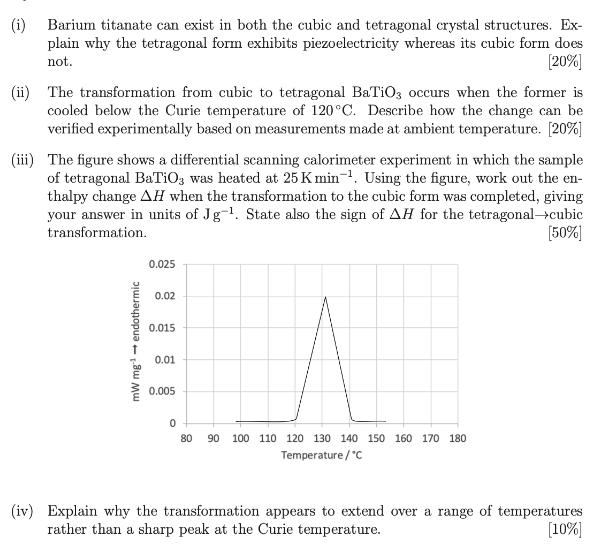Question
(i) Barium titanate can exist in both the cubic and tetragonal crystal structures. Ex- plain why the tetragonal form exhibits piezoelectricity whereas its cubic

(i) Barium titanate can exist in both the cubic and tetragonal crystal structures. Ex- plain why the tetragonal form exhibits piezoelectricity whereas its cubic form does not. [20%] (ii) The transformation from cubic to tetragonal BaTiO3 occurs when the former is cooled below the Curie temperature of 120C. Describe how the change can be verified experimentally based on measurements made at ambient temperature. [20%] (iii) The figure shows a differential scanning calorimeter experiment in which the sample of tetragonal BaTiO3 was heated at 25 K min-. Using the figure, work out the en- thalpy change AH when the transformation to the cubic form was completed, giving your answer in units of Jg-. State also the sign of AH for the tetragonal cubic transformation. [50%] mW mg endothermic 0.025 0.02 0.015 0.01 0.005 0 80 90 100 110 120 130 140 150 160 170 180 Temperature/"C (iv) Explain why the transformation appears to extend over a range of temperatures rather than a sharp peak at the Curie temperature. [10%]
Step by Step Solution
3.29 Rating (126 Votes )
There are 3 Steps involved in it
Step: 1
The image youve provided appears to contain a set of questions related to Barium titanate BaTiO and its phase transitions accompanied by a graph from a Differential Scanning Calorimeter DSC experiment ...
Get Instant Access with AI-Powered Solutions
See step-by-step solutions with expert insights and AI powered tools for academic success
Step: 2

Step: 3

Ace Your Homework with AI
Get the answers you need in no time with our AI-driven, step-by-step assistance
Get Started


